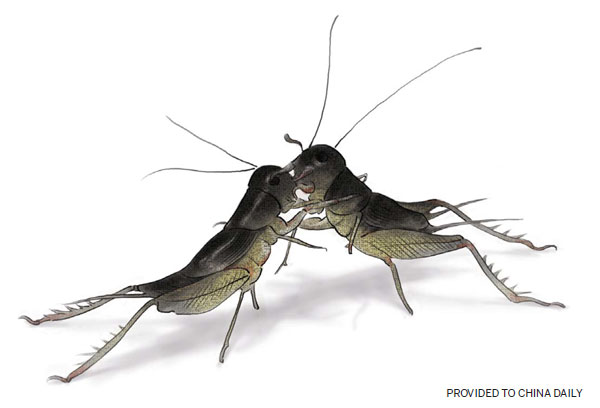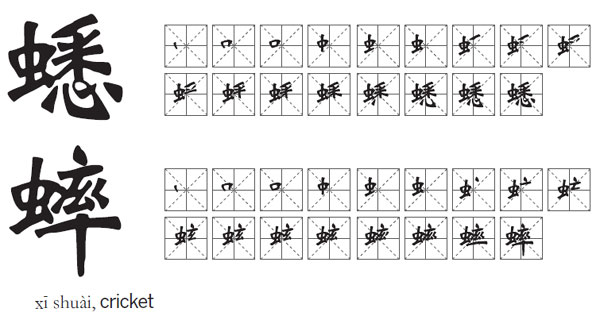May the best insect win
Updated: 2014-07-04 08:13
By Zhu Weijing (China Daily Europe)
|
|||||||||||


Making crickets fight has been part of Chinese culture for more than 1,000 years
A gaggle of men form a circle, sweat on their brows as they wave hundred yuan bills in the air in a darkly lit room in Beijing. Sure, gambling is illegal in China, but that won't stop these enthusiasts. The fight is on, and they wildly cheer on the two males in question. Adrenaline, tension, and expectation hang in the air. After just a few seconds, the slightly larger opponent has been pinned to the ground in defeat - the smaller insect is declared victor, before returning to his cage.
Characterized by speed, strength, and ferocity, cricket fighting is a popular, tension-filled spectator sport despite the small size of its combatants. In fact, cricket fighting bears a strong resemblance to boxing and wrestling.
Before the match, fighters are weighed and categorized into different weight classes; the cricket contenders can only compete with fighters in the same weight division. The two are then moved into the ring, separated by a divider in the middle. When the fight begins, the divider is lifted.
As soon as the two crickets sense each other, they immediately become alert and hostile, chirping their battle cries. Driven by their natural instincts, they engage in a duel for the privilege of mating. As with humans, males will go to considerable lengths to secure some action.
Like two wrestlers, the crickets size each other up first. They tackle, evade, break apart and sound their fury like Spartan warriors. The difference is that a fight between crickets, no matter how ferocious, never ends in bloodshed. It is hard to imagine just how fierce a fight between two small insects can be, but their jaws are very powerful. Some crickets have been known to bite through human skin and flesh.
For more than 3,000 years, the Chinese have kept crickets as pets, mostly for their pleasing chirps. But some people just want to watch a fight. Cricket fighting, 斗蟋蟀 dòuxīshuài, has been a popular sport in China for centuries, originating in the Tang Dynasty (AD 618-907).
When ancient Chinese discovered that if you locked these wild insects in a closed space, they start attacking each other, they soon took to the sport with gusto. Cricket fighting soon spread, and flourished during the Song Dynasty (960-1279).
Virtually all Chinese, no matter royal or common, indulged in cricket fighting. During the Qing Dynasty (1644-1911), cricket fighting was further developed as a serious sport, and theories on the selection of crickets expanded to better distinguish winners and losers. For anyone thinking of investing in his own stable of fighters, it is important to remember this general rule: "白不如黑,黑不如赤,赤不如黄" (bái bù rú hēi, hēi bù rú chì, chì bù rú huáng, white ones are inferior to black ones, black ones are inferior to red ones, and red ones are inferior to yellow ones).
Crickets, nicknamed 蛐蛐 qūqū, are also called 促织 cùzhī because ancient Chinese thought the chirping of crickets resembled the sound of looms, believing that the crickets were telling women to weave more before winter arrived. Since they only live for about 100 days in autumn, they are also called 百日虫 (bǎi rì chóng, a hundred-day insect).
For hundreds of years, crickets were a way of life for many, ranging from big fight tournaments to inclusion in fiction writing. In the story "The Cricket" (《促织》), from Strange Stories from a Chinese Studio (《聊斋志异》), Pu Songlin (蒲松龄), who wrote mainly in the 17th century, begins with the unhealthy obsession with crickets in Ming Dynasty (1368-1644) society: "Cricket fighting was very much in vogue at court, with levies of crickets being exacted from the people as a tax. … The price of crickets rose greatly; and when the beadle's runners came to exact even a single one, it was enough to ruin several families."
The story goes on to tell how a boy was almost beaten to death for losing a cricket his father prepared to submit to a magistrate, and his soul morphed into a fierce cricket to help his family survive.
Nowadays, cricket fighting is more recreational and is popular in Beijing and Zhejiang province. And, of course, there is some underground gambling. In underground casinos, the wager for a single fight can be as high as several thousand yuan, sometimes even tens of thousands.
Zhao Boguang, owner of a cricket store in Beijing, is a cricket-fighting master. A professional cricket breeder, he has long been in love with cricket fighting, ever since he began cricket combat against childhood friends in Beijing's hutong lane houses decades ago.
"A cricket cannot be trained to be a good fighter," Zhao says, "it is born a good fighter. This is why, although anyone can catch a cricket in the wild, crickets on the market can cost more than 10,000 yuan ($1,600, 1,180 euros).
Although there are limits to how much a cricket can be trained, experts say conditioning is essential to raise its dexterity and determination to win.
The night before a big match, Zhao lets his mightiest warrior indulge in an epic bout of lovemaking with its female partner. Stimulating and satisfying its sex drive are essential to maximizing the bug's inherent masculinity and helps ensure dominance during next day's combat.
During training sessions, he also uses a "探子" (tàn zǐ, a stick with rat whiskers or grass) to imitate his cricket's opponent. Pretending to be a cricket is also an essential step before the divider is lifted from the fighting ring at a match. A skilled trainer can lead a cricket into a most vicious frenzied state before the fight begins, and it will fight fearlessly against its opponent.
Crickets fight by instinct, but their techniques are ingenious. Some of the most classic finishing moves include: bawang juding (霸王举鼎), where the winning cricket hoists the other one and keeps its body in the air by locking with the opponent's jaws; xianren duoying (仙人夺影), a move that tricks the spectators when one cricket is lying on top of the other, yet the one that is on the bottom wins the fight; and gou qia ji (狗掐鸡), which is very similar to professional wrestler John Cena's signature move, in which the winning cricket uses its jaw strength to flip its opponent over.
There is one important rule in cricket fighting: A cricket that has lost never fights again. Master Zhao believes that crickets serve as the perfect example of a Chinese saying: 胜者为王,败者为寇 shèng zhěwéi wáng, bài zhě wéi kòu, meaning winners are crowned, and losers are outcasts. In the world of cricket fighting, it's once a loser, always a loser.
Courtesy of the World of Chinese, www.theworldofchinese.com
The World of Chinese
(China Daily European Weekly 07/04/2014 page27)
Today's Top News
Gambling costs World Cup fans their lives
US supports Ukraine's decision to suspend ceasefire
It's all about making a spectacle
China likely to see 7.5% growth in second quarter
Palace Museum feeling the squeeze of visitors
Myanmar pagoda replica given to China
US sends 300 more troops to Iraq over concerns
Hong Kong at the crossroads
Hot Topics
Lunar probe , China growth forecasts, Emission rules get tougher, China seen through 'colored lens', International board,
Editor's Picks

|

|

|

|

|

|





